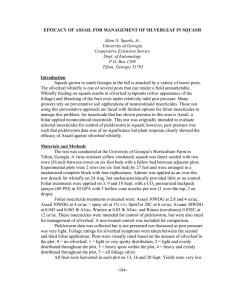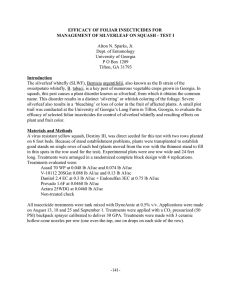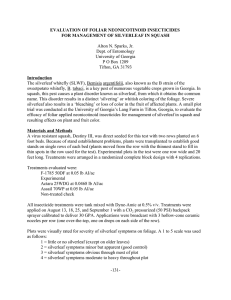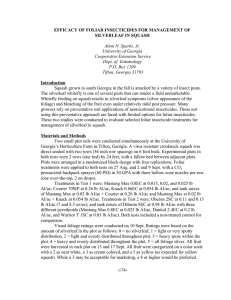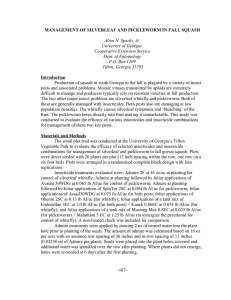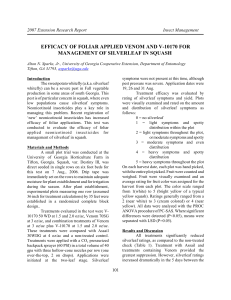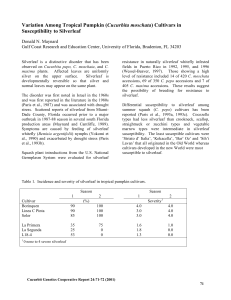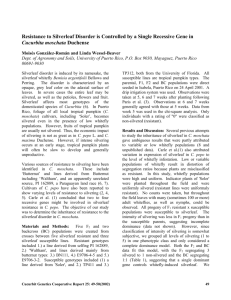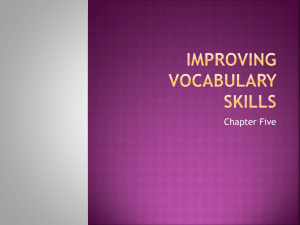Alton N. Sparks, Jr. and David G. Riley Dept. of Entomology
advertisement
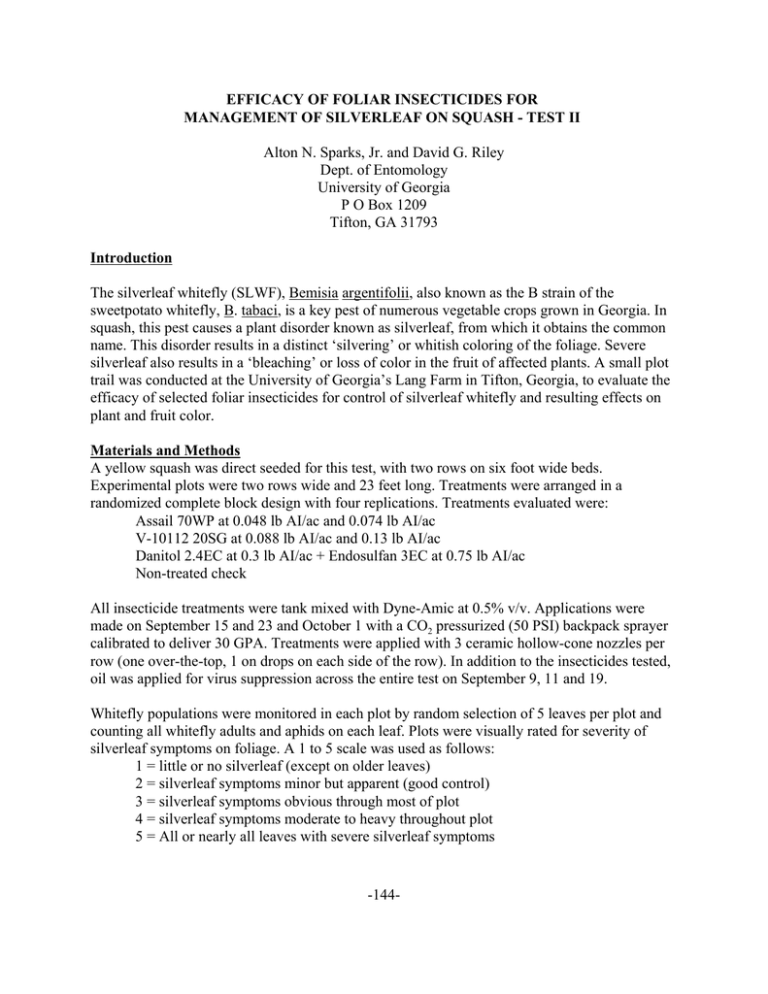
EFFICACY OF FOLIAR INSECTICIDES FOR MANAGEMENT OF SILVERLEAF ON SQUASH - TEST II Alton N. Sparks, Jr. and David G. Riley Dept. of Entomology University of Georgia P O Box 1209 Tifton, GA 31793 Introduction The silverleaf whitefly (SLWF), Bemisia argentifolii, also known as the B strain of the sweetpotato whitefly, B. tabaci, is a key pest of numerous vegetable crops grown in Georgia. In squash, this pest causes a plant disorder known as silverleaf, from which it obtains the common name. This disorder results in a distinct ‘silvering’ or whitish coloring of the foliage. Severe silverleaf also results in a ‘bleaching’ or loss of color in the fruit of affected plants. A small plot trail was conducted at the University of Georgia’s Lang Farm in Tifton, Georgia, to evaluate the efficacy of selected foliar insecticides for control of silverleaf whitefly and resulting effects on plant and fruit color. Materials and Methods A yellow squash was direct seeded for this test, with two rows on six foot wide beds. Experimental plots were two rows wide and 23 feet long. Treatments were arranged in a randomized complete block design with four replications. Treatments evaluated were: Assail 70WP at 0.048 lb AI/ac and 0.074 lb AI/ac V-10112 20SG at 0.088 lb AI/ac and 0.13 lb AI/ac Danitol 2.4EC at 0.3 lb AI/ac + Endosulfan 3EC at 0.75 lb AI/ac Non-treated check All insecticide treatments were tank mixed with Dyne-Amic at 0.5% v/v. Applications were made on September 15 and 23 and October 1 with a CO2 pressurized (50 PSI) backpack sprayer calibrated to deliver 30 GPA. Treatments were applied with 3 ceramic hollow-cone nozzles per row (one over-the-top, 1 on drops on each side of the row). In addition to the insecticides tested, oil was applied for virus suppression across the entire test on September 9, 11 and 19. Whitefly populations were monitored in each plot by random selection of 5 leaves per plot and counting all whitefly adults and aphids on each leaf. Plots were visually rated for severity of silverleaf symptoms on foliage. A 1 to 5 scale was used as follows: 1 = little or no silverleaf (except on older leaves) 2 = silverleaf symptoms minor but apparent (good control) 3 = silverleaf symptoms obvious through most of plot 4 = silverleaf symptoms moderate to heavy throughout plot 5 = All or nearly all leaves with severe silverleaf symptoms -144- On each harvest date, all fruit of harvestable size were collected from each plot and weighed. Number of fruit with virus symptoms (green spots or solid green) were counted. All fruit, except solid green fruit, were categorized by color based on a scale developed with PowerPoint graphics and number of fruit in each category was recorded. Fruit were rated on a 1 (white) to 11 (dark orange) scale, with most falling in the 2 to 6 range. A 2 on this scale is near white, a 3 is cream colored, and a 5 is a ‘normal’ bright yellow of a yellow squash. Data were analyzed with the PROC ANOVA procedure of PC-SAS. Where significant differences were detected (P<0.05), means were separated with LSD (P=0.05). Results and Discussion Pest densities were low in this test, however, all insecticide treatments provided suppression of whitefly adult populations (Table 1). Low densities of silverleaf whiteflies can produce severe silverleaf symptoms in squash as evident with the silverleaf ratings in this test (Table 1). All insecticides improved silverleaf ratings, with the greatest improvement obtained with Assail and V-10112. Both Assail and V-10112 showed significant rate effects on the October 2 silverleaf ratings, with the higher rates of both products providing better suppression of silverleaf symptoms. No differences were detected among treatments in total yields or number of fruit rated for color (Tables 2). Effects of treatments on fruit color are presented in Tables 3-5. In general, all of the insecticide treatments improved fruit color as compared to the check. Assail and V-10112 generally provided larger increases in the percent of fruit in the darker categories than the Danitol+Endosulfan treatment. Both Assail and V-10112 showed a trend for a rate effect, with the higher rates providing a greater increase in darker fruit, but this trend was statistically significant in only one case (Assail, Color 4-6 on Oct. 9). Overall, both Assail and V-10112 showed great promise as foliar insecticides for management of silverleaf whitefly and related problems in squash. Table 1. Insect densities and silverleaf ratings, SLWF efficacy trial, Tifton, Georgia, 2003. No. of SLWF adults per leaf Treatment Silverleaf ratings 9/16 9/24 10/02 9/24 10/02 Check 5.45 a 3.40 a 4.60 a 5.00 a 5.00 a Dan+Endo 1.60 b 0.20 c 1.65 b 4.25 a 3.75 b Assail 1.1 oz 1.20 b 1.55 b 1.05 b 2.50 b 2.75 c Assail 1.7 oz 1.50 b 0.95 bc 0.95 b 2.50 b 2.00 d V-10112 40g 1.10 b 1.30 bc 0.85 b 2.75 b 2.75 c V-10112 60g 0.95 b 0.85 bc 0.70 b 2.50 b 1.75 d Numbers within columns followed by the same letter are not significantly different (LSD; P=0.05) -145- Table 2. Average yields and number of fruit rated for color per plot, SLWF efficacy trial, Tifton, Georgia, 2003. Pounds of fruit per plot Treatment 10/03 10/09 Total Check 2.21 a 10.78 a 13.00 a Dan+Endo 2.46 a 12.88 a Assail 1.1 oz 3.38 a Assail 1.7 oz V-10112 40g No. of fruit color rated per plot 10/03 10/09 Total 9.75 a 38.50 a 48.25 a 15.34 a 10.75 a 44.25 a 55.00 a 11.69 a 15.06 a 15.50 a 41.50 a 57.00 a 2.99 a 13.17 a 16.15 a 11.50 a 45.00 a 56.50 a 3.03 a 12.32 a 15.35 a 12.50 a 38.75 a 51.25 a V-10112 60g 4.04 a 11.60 a 15.64 a 15.50 a 37.00 a Numbers within columns followed by the same letter are not significantly different (LSD; P=0.05) 52.50 a Table 3. Fruit color data for Oct. 3 harvest, SLWF efficacy study, Tifton, Georgia, 2003. Percent of fruit rated as indicated Treatment Color 6 Color 5-6 Color 4-6 Color 3-6 Color 2 Check 0.0 a 0.0 d 17.7 c 80.0 b 20.0 a Dan+Endo 4.2 a 7.7 cd 32.7 c 94.6 a 5.4 b Assail 1.1 oz 0.0 a 10.0 bcd 57.6 b 98.7 a 1.3 b Assail 1.7 oz 2.8 a 21.7 ab 76.7 ab 100.0 a 0.0 b V-10112 40g 3.1 a 16.4 abc 72.2 ab 100.0 a 0.0 b V-10112 60g 0.0 a 28.4 a 90.0 a 100.0 a 0.0 b Numbers within columns followed by the same letter are not significantly different (LSD; P=0.05) -146- Table 4. Fruit color data for Oct. 9 harvest, SLWF efficacy study, Tifton, Georgia, 2003. Percent of fruit rated as indicated Treatment Color 6 Color 5-6 Color 4-6 Color 3-6 Color 2 0.0 c 4.4 c 15.7 d 66.7 b 33.3 a Dan+Endo 10.9 bc 26.8 b 63.2 c 98.2 a 1.8 b Assail 1.1 oz 25.1 a 38.4 ab 66.7 bc 100.0 a 0.0 b Assail 1.7 oz 22.0 ab 39.7 ab 78.3 a 99.5 a 0.5 b V-10112 40g 25.1 a 43.3 a 70.0 abc 99.4 a 0.6 b Check V-10112 60g 26.6 a 46.5 a 77.3 ab 100.0 a Numbers within columns followed by the same letter are not significantly different (LSD; P=0.05) 0.0 b Table 5. Fruit color data for total harvest, SLWF efficacy study, Tifton, Georgia, 2003. Percent of fruit rated as indicated Treatment Color 6 Color 5-6 Color 4-6 Color 3-6 Color 2 Check 0.0 c 3.5 c 15.6 d 68.3 b 31.7 a Dan+Endo 9.2 bc 23.2 b 57.0 c 97.1 a 2.9 b Assail 1.1 oz 18.1 ab 30.3 ab 63.5 bc 99.5 a 0.5 b Assail 1.7 oz 17.9 ab 36.5 a 77.7 a 99.6 a 0.4 b V-10112 40g 19.9 a 36.9 a 70.5 ab 99.6 a 0.4 b V-10112 60g 18.8 ab 40.7 a 80.2 a 100.0 a Numbers within columns followed by the same letter are not significantly different (LSD; P=0.05) -147- 0.0 b
